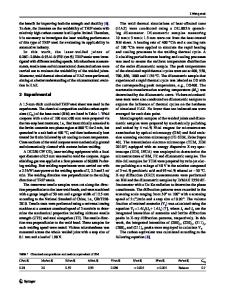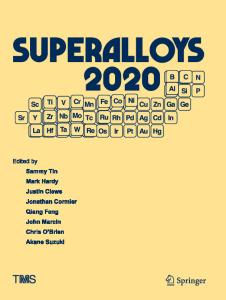Effect of process parameters on the microstructure and mechanical properties of AA2024 fabricated using selective laser
- PDF / 5,586,116 Bytes
- 18 Pages / 595.276 x 790.866 pts Page_size
- 80 Downloads / 352 Views
ORIGINAL ARTICLE
Effect of process parameters on the microstructure and mechanical properties of AA2024 fabricated using selective laser melting Mulla Ahmet Pekok 1 & Rossitza Setchi 1 & Michael Ryan 1 & Quanquan Han 2 & Dongdong Gu 3 Received: 23 July 2020 / Accepted: 2 November 2020 # The Author(s) 2020
Abstract Selective laser melting (SLM) offers significant benefits, including geometric freedom and rapid production, when compared with traditional manufacturing techniques. However, the materials available for SLM production remain limited, restricting the industrial adoption of the technology. The mechanical properties and microstructure of many aluminium alloys have not been fully explored, as their manufacturability using SLM is extremely challenging. This study investigates the effect of laser power, hatch spacing and scanning speed on the mechanical and microstructural properties of as-fabricated aluminium 2024 alloy (AA2024) manufactured using SLM. The results reveal that almost crack-free structures with high relative density (99.9%) and Archimedes density (99.7%) have been achieved. It is shown that when using low energy density (ED) levels, large cracks and porosities are a major problem, owing to incomplete fusion; however, small gas pores are prevalent at high-energy densities due to the dissolved gas particles in the melt pool. An inversely proportional relationship between ED and microhardness has also been observed. Lower ED decreases the melt pool size and temperature gradients but increases the cooling rate, creating a finegrained microstructure, which restricts dislocation movement, therefore increasing the microhardness. The highest microhardness (116 HV0.2), which was obtained from one of the lowest EDs used (100 J/mm3), is 45% higher than as-cast AA2024-0, but 17% lower than wrought AA2024-T6 alloy. Keywords Selective laser melting . Additive manufacturing . AA2024 . Process parameters . Mechanical properties . Microstructure
1 Introduction Aluminium (Al) and its alloys are extensively used in engineering applications, particularly in the transportation sector. The 2xxx series of Al alloys, especially, are preferred by the aerospace industry, owing to their strength, fatigue resistance and damage tolerance, along with high fracture toughness, which allows widespread use in airframe applications [1]. The significance of these alloys (particularly AA2024) in
* Rossitza Setchi [email protected] 1
Cardiff School of Engineering, Cardiff University, Cardiff CF24 3AA, UK
2
School of Mechanical Engineering, Shandong University, Jinan 250061, China
3
College of Materials Science and Technology, Nanjing University of Aeronautics and Astronautics, 29 Yudao Street, Nanjing 210016, China
other industrial sectors, including the automotive, construction, marine and defence industries, is also stated, due to their corrosion resistance, conductivity, malleability, recyclability, density and cost [2]. Further improvements in the microstructure and mechanical properties of these alloys using differ
Data Loading...











